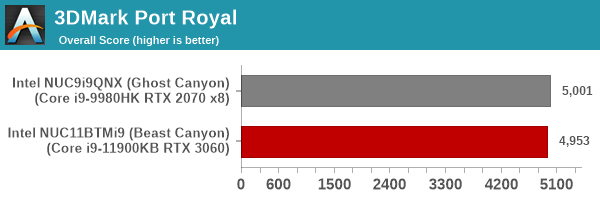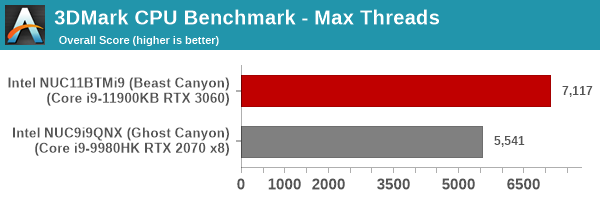Intel Beast Canyon NUC Review: Desktop Tiger Lake Debuts in SFF Gaming Powerhouse
by Ganesh T S on July 29, 2021 9:00 AM EST- Posted in
- Systems
- Intel
- NUC
- Tiger Lake
- NUC11
- Beast Canyon
UL Benchmarks - PCMark and 3DMark
This section deals with a couple of UL Futuremark benchmarks - PCMark 10 and 3DMark. While PCMark evaluates the system as a whole, 3DMark focuses on the graphics capabilities with emphasis on gaming workloads.
PCMark 10
UL's PCMark 10 evaluates computing systems for various usage scenarios (generic / essential tasks such as web browsing and starting up applications, productivity tasks such as editing spreadsheets and documents, gaming, and digital content creation). We benchmarked select PCs with the PCMark 10 Extended profile and recorded the scores for various scenarios. These scores are heavily influenced by the CPU and GPU in the system, though the RAM and storage device also play a part. The power plan was set to Balanced for all the PCs while processing the PCMark 10 benchmark.





3DMark
UL's 3DMark comes with a diverse set of graphics workloads that target different Direct3D feature levels. Correspondingly, the rendering resolutions are also different. We use 3DMark 2.4.4264 to get an idea of the graphics capabilities of the system. In this section, we take a look at the performance of the Intel NUC11BTMi9 (Beast Canyon) across the different 3DMark workloads.
3DMark Ice Storm
This workload has three levels of varying complexity - the vanilla Ice Storm, Ice Storm Unlimited, and Ice Storm Extreme. It is a cross-platform benchmark (which means that the scores can be compared across different tablets and smartphones as well). All three use DirectX 11 (feature level 9) / OpenGL ES 2.0. While the Extreme renders at 1920 x 1080, the other two render at 1280 x 720. The graphs below present the various Ice Storm worloads' numbers for different systems that we have evaluated.
| UL 3DMark - Ice Storm Workloads | |||

3DMark Cloud Gate
The Cloud Gate workload is meant for notebooks and typical home PCs, and uses DirectX 11 (feature level 10) to render frames at 1280 x 720. The graph below presents the overall score for the workload across all the systems that are being compared.

3DMark Fire Strike
The Fire Strike benchmark has three workloads. The base version is meant for high-performance gaming PCs. Similar to Sky Diver, it uses DirectX 11 (feature level 11) to render frames at 1920 x 1080. The Extreme version targets 1440p gaming requirements, while the Ultra version targets 4K gaming system, and renders at 3840 x 2160. The graph below presents the overall score for the Fire Strike Extreme and Fire Strike Ultra benchmark across all the systems that are being compared.
| UL 3DMark - Fire Strike Workloads | |||

3DMark Time Spy
The Time Spy workload has two levels with different complexities. Both use DirectX 12 (feature level 11). However, the plain version targets high-performance gaming PCs with a 2560 x 1440 render resolution, while the Extreme version renders at 3840 x 2160 resolution. The graphs below present both numbers for all the systems that are being compared in this review.
| UL 3DMark - Time Spy Workloads | |||

3DMark Night Raid
The Night Raid workload is a DirectX 12 benchmark test. It is less demanding than Time Spy, and is optimized for integrated graphics. The graph below presents the overall score in this workload for different system configurations.

3DMark Port Royal
UL introduced the Port Royal ray-tracing benchmark as a DLC for 3DMark in early 2019. The scores serve as an indicator of how the system handles ray-tracing effects in real-time.

3DMark CPU Profile Benchmark
UL recently introduced a benchmark to test the multi-threaded capabilities of the CPU in a system. Since gaming workloads are often multi-threaded, it makes sense to include this testing as part of the 3DMark suite. The benchmark routine attempts to perform the simulation of birds / bird-like objects flocking together using as many advanced capabilities as offered by the processor. The workload is configured to run with different number of threads ranging from 1 to 16 (and a single entry for the maximum number of threads allowed in the system).
| UL 3DMark - CPU Profile Benchmark | |||

We present the benchmark results for the single and maximum threads case above.
In almost all workloads, the Beast Canyon outscores other systems heavily. In the case of GPU-bound workloads, the tussle between the RTX 2070 in the Ghost Canyon and the RTX 3060 in the Beast Canyon is too close to call.










84 Comments
View All Comments
vegemeister - Friday, July 30, 2021 - link
Actual gaming consoles are stateless or nearly so, and get rebooted fresh every time they're used.PCs that are used for gaming do not work like that.
Spunjji - Friday, July 30, 2021 - link
I have literally never had a computer that wasn't overclocked fail due to a random bit-flip memory error, but okay, I guess they were all toys and we should all be paying extra for redundant chips on our DIMMs 🤷♂️willis936 - Friday, July 30, 2021 - link
What a valuable anecdote.mode_13h - Monday, August 2, 2021 - link
In PC help forums, it's not uncommon to find users complaining of system instability, only for it to turn out they have bad RAM. ECC buys you some initial protection + notification (if you know where to look) that your RAM is failing.Unashamed_unoriginal_username_x86 - Friday, July 30, 2021 - link
there is a scale of snobbery from gamer to anti-gamer and it is a horseshoeAlso ECC is still vulnerable to remote rowhammer attacks
Oxford Guy - Wednesday, August 11, 2021 - link
Yes... if you want more security you don’t want ECC. Security via data corruption!mode_13h - Thursday, August 12, 2021 - link
> remote rowhammer attacksThat's a new one! How does it even work? A rowhammer attack hits a DRAM row so frequently that an adjacent row changes. It's an *extremely* targeted attack, and requires the attacker to have some detailed knowledge of the target process' memory layout for it to have much potential as an exploit.
Furthermore, if it works, you're just going to cause random bit-flips. To beat ECC, you actually need to cause at least 3 bit flips, or I guess only 2 if your goal is to make the process abort.
Finally, to actually fetch a row of DRAM means it can't be in the cache hierarchy. So, you've got to explicitly invalidate the cacheline or do something else to ensure it's evicted.
So, the first question is how can one *remotely* hammer a row of DRAM? Wouldn't any sort of protection against DoS attacks occur, long before you could do it? And how are you going to ensure it keeps getting evicted from the cache hierarchy?
In actual practice, the only real risk I see of Rowhammer is when one VM tenant just wants to create lots of chaos in the other tenants. It's not a complete non-issue, but also probably ranks fairly low on the scale of exploits.
And it's *certainly* not an argument against using ECC. If anything, it's yet another reason *to* use it, since ECC can correct minor instances and detect many others. Without ECC, you'd be even *more* vulnerable, and you'd be much less likely to have any clue that it's happening.
ads295 - Thursday, July 29, 2021 - link
One usually moves towards desktop PCs in order to move away from expensive-to-replace custom hardware found in laptops, amongst other things. I would not buy this if it was going to cost a bomb to replace in case of some motherboard related issue.meacupla - Thursday, July 29, 2021 - link
Other than the CPU and compute unit pcb itself, I don't see anything on the compute unit that isn't easily replaceable.PSU, GPU, RAM and SSD are all replaceable, which is really about as good as it gets for something that is using laptop parts.
Going to a desktop, the only additional thing you can replace is the CPU.
Spunjji - Friday, July 30, 2021 - link
"Other than the CPU and compute unit pcb itself"That's a pretty big "other than!" - if an ITX motherboard fails, you can replace that without buying a new CPU. Same goes for an upgrade / replacement of the CPU itself. Those are at least ~$150+ and ~$350+ expenses, respectively, for something of this calibre.